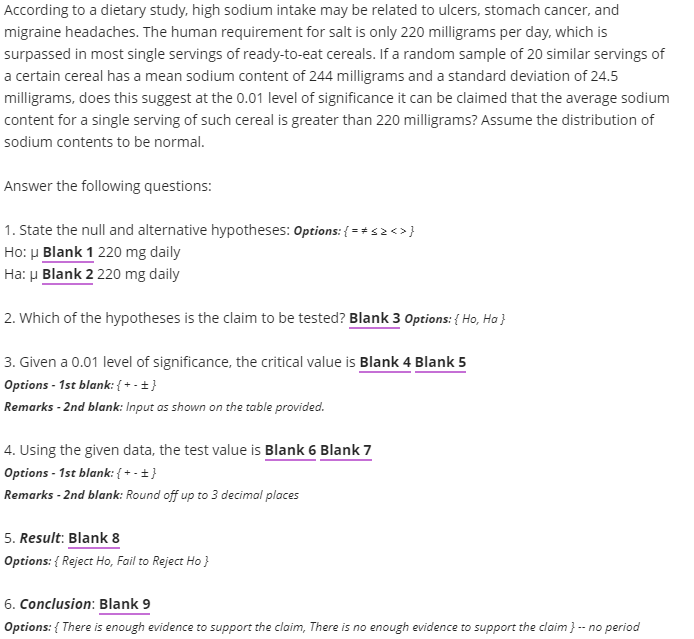According to a dietary study, nign sodium intake may be related to uicers, stomach cancer, and migraine headaches. The human requirement for salt is only 220 milligrams per day, which is surpassed in most single servings of ready-to-eat cereals. If a random sample of 20 similar servings of a certain cereal has a mean sodium content of 244 milligrams and a standard deviation of 24.5 milligrams, does this suggest at the 0.01 level of significance it can be claimed that the average sodium content for a single serving of such cereal is greater than 220 milligrams? Assume the distribution of sodium contents to be normal. Answer the following questions:
According to a dietary study, nign sodium intake may be related to uicers, stomach cancer, and migraine headaches. The human requirement for salt is only 220 milligrams per day, which is surpassed in most single servings of ready-to-eat cereals. If a random sample of 20 similar servings of a certain cereal has a mean sodium content of 244 milligrams and a standard deviation of 24.5 milligrams, does this suggest at the 0.01 level of significance it can be claimed that the average sodium content for a single serving of such cereal is greater than 220 milligrams? Assume the distribution of sodium contents to be normal. Answer the following questions:
A First Course in Probability (10th Edition)
10th Edition
ISBN:9780134753119
Author:Sheldon Ross
Publisher:Sheldon Ross
Chapter1: Combinatorial Analysis
Section: Chapter Questions
Problem 1.1P: a. How many different 7-place license plates are possible if the first 2 places are for letters and...
Related questions
Question
Need help ASAP :(

Transcribed Image Text:According to a dietary study, high sodium intake may be related to ulcers, stomach cancer, and
migraine headaches. The human requirement for salt is only 220 milligrams per day, which is
surpassed in most single servings of ready-to-eat cereals. If a random sample of 20 similar servings of
a certain cereal has a mean sodium content of 244 milligrams and a standard deviation of 24.5
milligrams, does this suggest at the 0.01 level of significance it can be claimed that the average sodium
content for a single serving of such cereal is greater than 220 milligrams? Assume the distribution of
sodium contents to be normal.
Answer the following questions:
1. State the null and alternative hypotheses: Options: { = *s2<>}
Ho: µ Blank 1 220 mg daily
Ha: u Blank 2 220 mg daily
2. Which of the hypotheses is the claim to be tested? Blank 3 Options: { Ho, Ha }
3. Given a 0.01 level of significance, the critical value is Blank 4 Blank 5
Options - 1st blank: { + - +}
Remarks - 2nd blank: Input as shown on the table provided.
4. Using the given data, the test value is Blank 6 Blank 7
Options - 1st blank: { + - +}
Remarks - 2nd blank: Round off up to 3 decimal places
5. Result: Blank 8
Options: { Reject Ho, Fail to Reject Ho }
6. Conclusion: Blank 9
Options: { There is enough evidence to support the claim, There is no enough evidence to support the claim } -- no period
Expert Solution
This question has been solved!
Explore an expertly crafted, step-by-step solution for a thorough understanding of key concepts.
This is a popular solution!
Trending now
This is a popular solution!
Step by step
Solved in 2 steps

Recommended textbooks for you

A First Course in Probability (10th Edition)
Probability
ISBN:
9780134753119
Author:
Sheldon Ross
Publisher:
PEARSON


A First Course in Probability (10th Edition)
Probability
ISBN:
9780134753119
Author:
Sheldon Ross
Publisher:
PEARSON
